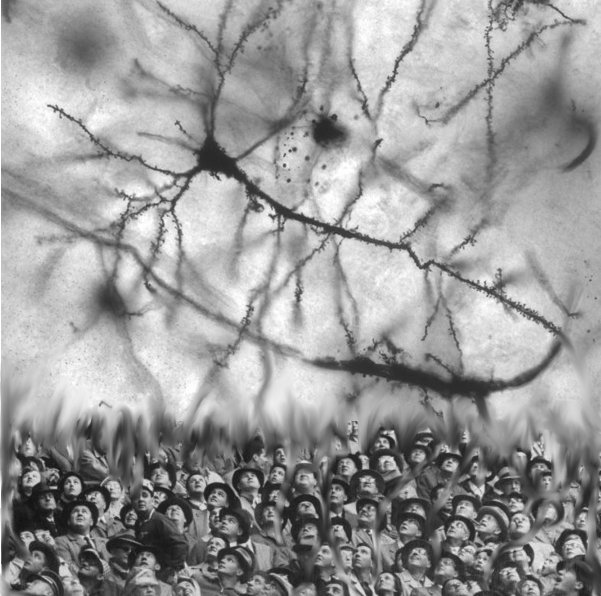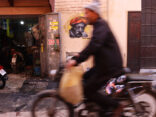Autore
Indice
- Introduction
- From designing of anti-seismic macro-structures to the tuning of micro-earthquakes to selective destroy tumor cells: oncology or engineering?
- Fuzzy boundaries between living and non-living worlds delineated by the phase-transition paradigm in cells: a philosophic challenge?
- Competition and cooperation in biomechanics: engineering meets behavioral sciences
- Conclusions
S&F_n. 11_2014
Abstract
By traveling through the inner structure of biological tissues, for instance by means of a scanning or a transmission electron microscope, unexpectedly exact geometries and symmetries in the form of perfect lattices, honeycomb networks, helical macromolecules and polyhedral shapes resulting from minimal surfaces can be observed. Furthermore, by exploring cells and tissues at meso-, micro- and nano-scale levels, one discovers that self-similarity and hierarchy replicate that geometrical order and surprisingly characterize all the biological architectures, in this way de facto governing the key biomechanical functions and biochemical signaling at the basis of the life. The apparent extreme shape minimalism that nature exhibits when analyzed at sub-macroscopic level is therefore deceptive and thrilling at the same time: the geometrical neatness is indeed often counterbalanced by extremely complex functional relationships and multi-physical interactions – occurring over different spatial and time scales – which force who tries to interpret the dynamics of biological systems through mathematical models to somewhat reconsider matters that he/she previously deemed foundations, the need to respond to new fundamental questions raised by counterintuitive events and seeming paradoxes trouncing the cultural barriers that traditionally separate the disciplines and obscure the beauty.
- Introduction
By traveling through the inner structure of biological tissues, for instance by means of a scanning or a transmission electron microscope, unexpectedly exact geometries and symmetries in the form of perfect lattices, honeycomb networks, helical macromolecules and polyhedral shapes resulting from minimal surfaces can be observed. Furthermore, by exploring cells and tissues at meso-, micro- and nano-scale levels, one discovers that self-similarity and hierarchy replicate that geometrical order and surprisingly characterize all the biological architectures, in this way de facto governing the key biomechanical functions and biochemical signaling at the basis of the life. The apparent extreme shape minimalism that nature exhibits when analyzed at sub-macroscopic level is therefore deceptive and thrilling at the same time: the geometrical neatness is indeed often counterbalanced by extremely complex functional relationships and multi-physical interactions - occurring over different spatial and time scales - which force who tries to interpret the dynamics of biological systems through mathematical models to somewhat reconsider matters that he/she previously deemed foundations, the need to respond to new fundamental questions raised by counterintuitive events and seeming paradoxes trouncing the cultural barriers that traditionally separate the disciplines and obscure the beauty.
In what follows, I collect some (perhaps ingenuous) considerations – the most part of which are explicitly referred to recent results and current studies I’m working on – whose common denominator resides in the fact that the related themes, somehow, do not inhabit one the reassuring houses built up with thick walls by the several disciplinary areas, but most likely can be found wandering in the gardens of those houses – or skipping fences.
- From designing of anti-seismic macro-structures to the tuning of micro-earthquakes to selective destroy tumor cells: oncology or engineering?
An Earthquake is an event – sometimes catastrophic and often unforeseeable – due to a sudden release of energy in the Earth’s crust that produces seismic waves: at the Earth’s surface it manifests itself by shaking, fracture and displacement of the ground, and sometimes can accompany (or may trigger) landslides and volcanic activities. At the “macroscopic scale” – the scale at which we are all familiar with earthquakes – the task for civil engineers is to design anti-seismic structures and systems able to dissipate energy for protecting existing buildings and make constructions resistant to seismic attacks.
At the “microscopic scale”, say the scale of human cells, the cytoskeleton (CSK) – a complex network of hierarchically organized polymers involving actin filaments, microtubules and a group of accessory polymers collectively known as intermediate filaments – constitutes the bearing structure of the cell. Contractile microfilaments in fact generate and distribute tension to all cell CSK filament systems, locally resisting compression when either cross-linked within large bundles or contracted to their shortest length. Microtubules also resist compression in cells, possibly because they are stabilized against buckling by lateral interconnections with tensionally stiffened intermediate filaments. The CSK network confers to the cell the skill to resist deformation and its architecture, determined from self-assembly-disassembling mechanisms dynamically regulated by the polymerization and depolymerization processes of actin filaments and microtubules continuously changing to find new optimal equilibrium configurations, controls the physical properties of the whole cell, mediating the linkage of the cell with the outside environment and modulating the process of recognition and conversion in chemical activities of mechanical stimuli (mechanotransduction). In this way, the cell CSK structure governs short and long timescale changes in cellular behavior, reorganizing the network in response to externally applied forces, arranging and maintaining the integrity of intracellular compartments and in turn generating directed forces that guide cell shape changes necessary to carry out specific functions, such as crawling, spreading, division, contraction, migration, adhesion and invasion.
From the theoretical point of view, the tensegrity paradigm – an original idea by Donald Ingber of actually modeling CSK as an engineering pre-tensioned micro-structure – has demonstrated to provide a plausible explanation for some CSK stiffening responses, also allowing to understand how a local stress, induced by ligation of a subset of CSK-associated membrane receptors, can result in global modulation (immobilization) of receptors over the entire cell surface through the balancing of forces in cell structural elements characterized by a level of isometric tension, or pre-stress, that guarantees the overall cell-shape stability and long-distance force transfer.
If the cell CSK is a structure and force transmitting mechanisms play a crucial role in the biochemical regulation of cell activities, what about cell response to dynamic excitations? Is it possible to exploit structural engineering weapons to design new mechanically-based strategies and approaches for stimulating/manipulating cells? It has been experimentally established, for example, that mechanical stress inhibits tumor growth, but overwhelming obstacles to the therapeutic translation in medicine of these laboratory results arise when moving from in-vitro to in-vivo, because the same inhibition stress level generally kills (or affects) the normal tissues too, and selective loads are difficult to apply!
Very recently, however, experiments have demonstrated that CSK mechanical properties of cells could be potentially relevant to discriminate among cancer and healthy cells, highlighting the possibility of measuring – independently from the cell lines – a significant difference in elastic stiffness between metastatic and normal cells, the former being about 70% softer than the latter.
In principle – as in the case in which the seismic waves invest a town and selectively make collapsing the sole buildings whose oscillation frequencies match the earthquake ones (mechanical resonance) – differences in healthy and tumor cell stiffness could be exploited to design micro-earthquakes, for example tuning ultrasounds in frequency and magnitude to selectively destroy cancer cells. Literature already have shown that stem cells can be induced to renew themselves through mitotic division and differentiating into a specialized cell type, if stimulated in an opportune way. A signal of the potential for tumor therapy and other medical applications of a mechanical-based stimulation can be also traced in very recent works, where the effects of ultrasounds treatment on adult resident cardiac primitive cells have been examined demonstrating the positive influence on both the proliferation and the differentiation of cardiomyocytes, smooth muscle and endothelial cells precursors.
This is a ground on which all the sciences are called to pave the way – and break down the barriers.
- Fuzzy boundaries between living and non-living worlds delineated by the phase-transition paradigm in cells: a philosophic challenge?
An additional interesting perspective has been recently furnished by Gerald H. Pollack, professor of bioengineering at the University of Washington in Seattle and leader in the field of muscle contraction and motility, by exploring the possibility that the gel-like nature of the cell cytoplasm – gel being a matrix of polymers to which water and ions cling – and the related phase-transition phenomena could explain the most part of the cell functions, say material transport, motility, division, secretion, communication, contraction and other cell activities, in this way suggesting an intriguing interpretation of the confines between living and non-living structures which would ask for a philosophical thought. Actually, by exploiting the Pollack words, the relevance of phase transition for the cell is not difficult to envision, “contraction arising out of shrinkage, motility arising out of shape change, transport arising out of solute separation, action potentials arising out of permeability change, etc.” Of the phase-transition interpretational paradigm, the most attractive feature is constituted by the “prodigious response that can be elicited by subtle environmental shift such a slight change of temperature or pH”, such amplification being enhanced further in biological structures as a consequence of the high – and sometimes unexpected – degree of order and symmetry commonly exhibited by them. Whereas synthetic gels are in fact typically built of tangled polymers with relatively modest order, “cellular organelles such as the ciliary axoneme and muscle sarcomere exhibit extraordinary supramolecular order, with X-ray diffraction patterns showing regularity down to about 1 nanometer. With structural regularity, the triggering threshold should be the same everywhere, and the response should therofore be decisive and rapid”. By following this line of reasoning – indeed experimentally comforted – symmetry and order surprisingly seem to rise to the fundamentals of the life machine, somehow in contrast with the intuitive collective imagination which associates organic and living to geometrically muddled. Actually, the phase-transition model can be utilized to also explain dynamics of cells through the so-called transition cooperativity concept, which moves from the above described high sensitivity of ordered microstructures to slight changes – or gradients – of signals and stimuli. Cooperativity generally arises out of competition between two or more forces, in the case of polymer strand the competing forces arising from the polymer’s attraction to water and to polymer. Cooperative propagation mimics (or is?) a living behaviour and in polymers may be observed – or realized – by exploiting the mechanism based on the “Association-Induction” hypothesis: “in a carbon chain such as that of a protein or polymer, local structural change produces an electron-cloud shift, which induces a similar cloud shift and structural change in the next region [...] thus, the transition propagates along the polymer [...] analogously to what happens when a magnet is brought near an array of nails loosely strung to one another with bits of string [...]. The first nail is magnetized, which magnetizes the second, etc., until many or all nails are recruited into the new configuration. In such a way the structural change propagates”.
These cooperative mechanisms and the underlying phase-transition hypothesis thus forces us to re-think the definition of life, cellular processes and cells themselves operating – and living – obeying the same physical and chemical principles that govern ordinary non-biological systems.
As defiantly postulated by Pollack, “[...] presupposing similar principles operating on either side of the boundary provides an appropriately seamless transition between living and non-living [...] the notion of continuity across the living – non-living boundary seems logical because the boundary is fuzzy. Is the seed living? What about the virus?” – but one might add the question: what about life, and death!?
- Competition and cooperation in biomechanics: engineering meets behavioral sciences
Modeling living tissues implies a significant effort to gain insights into the basic understanding of the dynamics which cells, tissues and organs obey. This in turn forces to think how to catch the essential mechanisms governing growth, remodeling and morphogenesis at the different scale levels, open-mindedness being the fundamental weapon and the precondition for this exploration.
As a result of growing interest of the biomedical research for the new scenarios recently opened in the field of therapy and diagnosis of human diseases by the designing of drug delivery systems as well as by the applications of tissue engineering and biomaterials, the mechanical properties and the underlying hierarchical organization of living tissues represent to date issues of primary interest in biomechanics, cancer-related topics being obviously at the center of the interest.
Cancer can be viewed as a disease involving irreversible genomic alterations affecting intrinsic cellular cycles. These genomic alterations act in combination with the modification of the environmental conditions defined by immune response, matrix metabolism and stiffness, mechanical and biochemical gradients.
The growth of solid tumors can be treated physically as a mechanical process according to which a heterogeneous tissue expands within a surrounding medium. Tumor expansion is controlled by some internal driving stresses, which are counterbalanced by mechanical resistance provided by the surrounding environment. Internal stresses are mostly generated by cells proliferation dynamics, which is influenced by the diffusion of nutrients within the tumor. This implies that the physical forces pushing the tumor ahead do not involve the sole surface tension and the pressure of the surrounding medium, but also the explicit active cellular forces deputy in the momentum balance that, in turn, retrospectively activate mechanosensitive cellular processes.
With the aim to gain some new insights into the basic understanding of the complex machine of the host-tumor interaction in growing solid tumors, heterogeneous poroelastic models of tumor spheroids can be helpfully constructed taking into account the mechanically activated stress fields, fluid pressure and nutrient walkway all coupled with spatially inhomogeneous and time-varying bulk growth.
Actually, the growth is a result of competitive-cooperative dynamics occurring at the microscopic scale level among healthy cells, cancer cells and extra-cellular matrix (ECM) and – in principle – should not be assumed a-priori. Nevertheless, these dynamics are generally neglected in engineering models, as a consequence of both the difficulty of mathematically describing them with sufficient accuracy and the problems arising from the coupling of competition equations with mechanical ones.
To try to overcome these limits – which significantly reduce the aptitude of the mathematical models to predict the destiny of tumor masses – the idea is to macroscopically model the dynamics occurring at microscopic scales by introducing ad hoc non-linear Lotka/Volterra-like equations, extensively utilized to describe ecological systems as well as several population dynamics which involve psychological and collective behaviors of social communities.
The basic idea is that cancer and healthy cell species do not compete directly, as it would happen in a pure predator-prey logic, but fight to contend the common resources occupying the shared environment. The common resources are thus constituted by the available fluid content supposed to be saturated of nutrients, the environment being simply represented by the space that cells can inhabit at a certain time during growth and proliferation processes. The introduction of this transitive effect, that permeates through the system and enriches previously proposed poroelastic models, seems to well mimics the actual competition among cell species by reproducing the experimentally observed coupled dynamics in which the presence of one species tends to somehow limit the development of the other. This mutual inhibition in turn modifies the intrinsic growth rates of the cell populations and leads to spatially inhomogeneous elastic and residual stresses as well as non-uniform interstitial fluid pressure distributions within the tumor spheroid.
Although some features depending on the direct competition between cancer and healthy cells (such as the anti-oncogenic potentials of some immune cells or the aggressiveness of pre-malignant cells which become malignant as a result of mutation processes) remains to date still partially excluded, the choice of coupling mechanics with collective (social) behavioral schemes for cells seems to limpidly elucidate the key aspects at the basis of the dynamics of tumors, suggesting that – as stated by Pollack – parsimony prevails when “layers of apparent complexity collapse into a few simply governing principles”.
- Conclusions
In Lectures on Physics – an undisputed milestone in the field – Richard Feynman, one of the greatest physicists of all time known to have received the Nobel Prize in 1965 for his contributions to the theory of quantum electrodynamics, devoted a chapter of the book to the relation of physics to other disciplines. In those pages he originally – and somehow lightly – faced several themes and opened up on multidisciplinary horizons, by envisaging possible challenges in exploring memorizing mechanisms and nervous system brain cells and functions from both chemo-physical and psychology standpoints, to then discuss the “historical question” (so called, he said, for “lack of a better term”), a paradigm for highlighting an intrinsic difference between biology (and perhaps other human sciences) – interested in the theory of evolution – and physics, that does not have questions about its laws like “how did they get that way?”.
At the end, he concluded with a phrase destined to be famous: “A poet once said, “The whole universe is in a glass of wine.” We will probably never know in what sense he meant it [...]. But it is true that if we look at a glass of wine closely enough we see the entire universe. There are the things of physics: the twisting liquid which evaporates depending on the wind and weather, the reflection in the glass; and our imagination adds atoms. The glass is a distillation of the earth’s rocks, and in its composition we see the secrets of the universe’s age, and the evolution of stars. What strange array of chemicals are in the wine? How did they come to be? There are the ferments, the enzymes, the substrates, and the products. There in wine is found the great generalization; all life is fermentation. [...] If our small minds, for some convenience, divide this glass of wine, this universe, into parts – physics, biology, geology, astronomy, psychology, and so on – remember that nature does not know it! So let us put it all back together, not forgetting ultimately what it is for. Let it give us one more final pleasure; drink it and forget it all!”.
However, Feynman (and Pierre Louis Maupertuis) should have been present to assist to a recent wonderful lecture at the University of Napoli Federico II by Sir Anthony James Leggett, professor of physics at the University of Illinois at Urbana-Champaign (he began studying Literae Humaniores at Oxford) and Nobel Prize in Physics in 2003 for his pioneering work on superfluidity. In that occasion professor Leggett explained what he was dealing with, then illustrating how he had persuaded, on the basis of both experimental facts and theoretical (Quantum-Mechanics based) arguments, that the arrow of time could – locally and temporarily – reverse! By putting aside, elegantly, any “usual” consideration on time machines (and avoiding to recall the film Back to the future) he skipped mathematical and physical details and instead raised a new question, that is the necessity to admit that the induction principle (i.e. “past causes future, not vice versa”) had to be violated. The implications for “free will”, determinism and anything today seems to be obvious – or natural – are enormous, but, perhaps, the message contained in that slide was semantically even stronger: it is the most effective warning to bring together all forms of human thoughts given that, as stated by Wittgenstein, The limits of my language means the limits of my world.








